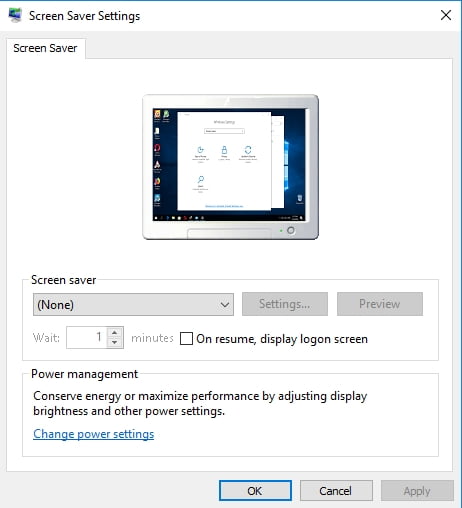- Here are our top 16 tips to cure your PC’s hypersomnia:
- 1. Use Task Manager
- 2. Tweak Windows 10 Sleep Mode Settings
- 3. Restore Power Plan Defaults
- 4. Use Registry Editor
- 5. Configure Display Timeout
- 6. Optimize Screen Saver Settings
- 7. Examine the Battery
- 8. Disable the Theme
- 9. Update Your OS
- 10. Run a System Scan
- 11. Run Power Troubleshooter
- 12. Change What the Power Buttons Do
- 13. Check for Problematic Drivers
- 14. Reset Your BIOS
- 15. Check for Corrupt or Missing System Files
- 16. Perform a Complete Checkup
![PC Keeps Going to Sleep Issue [Fixed]](png/11.windows_goes_into_sleep_mode.png)
‘There’s no rest when you’re on planetary duty’
Paul Watson
Looking forward to bedtime in coming to work each day? Dear friend, our sympathy goes to you. And we know you can have your cup of coffee and knuckle down to some serious business.
But what if your Windows 10 keeps going into sleep after a few minutes idle? Regrettably, a dose of caffeine won’t help. And your computer has countless commitments to live up to.
Unfortunately, excessive Windows 10 sleepiness is a common concern these days. Users keep reporting their computers going into sleep mode after an unreasonably short period of time: 3-4 minutes of inactivity are enough to trigger the issue. Some devices are stated to enter Windows 10 sleep mode after 1 minute idle – what a nice way of slacking off at work!
Lucky for us, despite being terribly frustrating, the Win 10 sleep mode problem is pretty fixable.
Here are our top 16 tips to cure your PC’s hypersomnia:
- Use Task Manager
- Tweak Windows 10 Sleep Mode Settings
- Restore Power Plan Defaults
- Use Registry Editor
- Configure Display Timeout
- Optimize Screen Saver Settings
- Examine the Battery
- Disable the Theme
- Update Your OS
- Run a System Scan
- Run Power Troubleshooter
- Change What the Power Buttons Do
- Check for Problematic Drivers
- Reset Your BIOS
- Check for Corrupt or Missing System Files
- Perform a Complete Checkup
So, let’s get your PC back on track by breaking its bad sleep habits:
1. Use Task Manager
First and foremost, open your Task Manager and look out for ‘not responding’ programs – they might cause the lethargy shown by your PC.
Here’s what you should do:
Ctrl + Alt + Del -> Task Manager -> Processes -> Select the problematic program -> End task
If frozen programs are not the case, keep moving ahead.
2. Tweak Windows 10 Sleep Mode Settings
To combat your computer’s persistent sleepiness, try adjusting the Windows 10 sleep mode settings:
- Start -> Control Panel -> Power Options
- Choose when to turn off the display -> Change advanced power settings -> Adjust the options to your needs -> Apply
If your PC keeps being intolerably drowsy, try out the following trick.
3. Restore Power Plan Defaults
Another tip to keep your computer from going to sleep randomly is to restore its default power plan settings:
- Start -> Settings -> Power & sleep
- Additional power settings -> Choose when to turn off the display -> Restore default settings for this plan
No such option? Then go to:
Choose when to turn off the display -> Change advanced power settings -> Restore plan defaults
All to no avail? Then it is time to let your Registry Editor have a go.
4. Use Registry Editor
Here are 6 easy steps to fix your listless computer using Registry Editor:
- Windows logo key + S -> Type regedit -> Right-click on Registry Editor -> Run as Administrator
- Navigate to HKEY_LOCAL_MACHINE\SYSTEM\CurrentControlSet\Control\Power\PowerSettings\238C9FA8-0AAD-41ED-83F4-97BE242C8F20\7bc4a2f9-d8fc-4469-b07b-33eb785aaca0
- Right-click Attributes -> Type 2
- Close Registry Editor
- Well done! Now go to: Win key -> Type Power Options -> Open Power Options -> Selected Plan -> Change Plan Settings -> Change Advanced Power Settings
- Click on Change Settings that are Currently Unavailable -> Sleep -> System Unattended Sleep Timeout -> Set your preferred settings
Congratulations!
Too early for that? Then keep working your way down.
5. Configure Display Timeout
You can address the ‘Windows 10 goes to sleep too fast’ drama by configuring your display timeout.
Here is how to do that:
- Windows Key + X -> Command Prompt (Admin)
- Type the commands for the times when your laptop is
plugged in:
powercfg.exe /setacvalueindex SCHEME_CURRENT SUB_VIDEO VIDEOIDLE <time in seconds>
powercfg.exe /setacvalueindex SCHEME_CURRENT SUB_VIDEO VIDEOCONLOCK <time in seconds>
powercfg.exe /setactive SCHEME_CURRENT
in battery mode:
powercfg.exe /setdcvalueindex SCHEME_CURRENT SUB_VIDEO VIDEOIDLE <time in seconds>
powercfg.exe /setdcvalueindex SCHEME_CURRENT SUB_VIDEO VIDEOCONLOCK <time in seconds>
powercfg.exe /setactive SCHEME_CURRENT
Note: Set <time in seconds> before the display timeout. - Close everything -> Restart your PC

Does the problem remain unresolved?
There is no need to despair – you still have lots of tricks up your sleeve.
6. Optimize Screen Saver Settings
Tweaking your screen saver this way may save the day:
- Start -> Control Panel -> Appearance and Personalization -> Screen Saver
- Set its sleep settings to None or choose the amount of time you like -> Restart your computer

Does the issue persist?
Well, your battery might be feeling a bit under the weather.
7. Examine the Battery
If tweaking your PC’s sleep settings was to no avail, take a closer look at your battery – it might be the culprit.
Does the issue persist only when you are running your laptop off the battery? If so, remove the battery from the laptop, wait for a while and then reinsert it. If your PC keeps going into sleep, we recommend you to have your computer serviced – your battery might need replacement or a firmware update.
8. Disable the Theme
The sad truth is, your nice-looking theme might be the cause of your Windows 10 having a ‘sleep disorder’.
There is nothing left to do but go back to the default theme:
Windows + S -> Type “themes” -> Go to the theme settings -> Select the default theme -> Exit
9. Update Your OS
If your Windows 10 is acting weird and keeps falling asleep after a few minutes idle, check if there are any updates waiting to be installed on your PC.
Make use of Windows Update:
Start -> Settings -> Update & Security -> Check for updates -> Let your Windows 10 download and install new updates
Keep in mind that not only helpful updates arrive at your PC: for instance, if you Windows 10 is suspiciously sleepy, some malicious programs might have penetrated your system and stolen a march on your antivirus.
10. Run a System Scan
Excessive Windows 10 sleepiness can be a symptom of malware infection. Indeed, some malicious invaders might have tampered with your power settings.
We recommend you to scan your operating system with your main anti-virus software.
If you do not have a third-party security solution installed, make use of the built-in Microsoft Windows Defender:
Start -> Settings -> Update & Security -> Windows Defender -> Open Windows Defender -> Full
Besides, a special anti-malware tool can contribute to the investigation into the case: for example, Auslogics Anti-Malware can detect and remove the nefarious intruders your main security solution may miss.
11. Run Power Troubleshooter
To fix the issues that put your PC into sleep mode after a few minutes of inactivity, try running Power Troubleshooter – it is aimed at resolving the most common problems with your power plan.
To run Power Troubleshooter, do the following:
Windows key + S -> Type Troubleshooting -> Select the result -> System and Security -> Power -> Follow the onscreen guidelines
No luck so far?
Then proceed to the following trick.
12. Change What the Power Buttons Do
If none of the above has fixed your issue, try tweaking the Power Buttons:
- Start -> Contol panel -> Hardware and Sound
- Power Options -> What the power buttons do -> Choose Do nothing for all the options
And what if the Power Buttons have nothing to do with your Windows 10 sleep problems?
It is time to look for dodgy drivers.
13. Check for Problematic Drivers
Faulty or outdated drivers can bring about Windows 10 sleep mode problems.
Here are some tips to get your drivers in tip-top shape:
Make Use of the Built-in Windows Tools
To fix your driver issues in Windows 10, try using:
- Windows Driver Verifier (Start menu -> Type verifier -> Enter)
- Device Manager (Win + X -> Device Manager -> Expand the device entries -> Search for the problematic driver -> Right-click on it and select Update Driver Software)
Troubleshoot Your Drivers Manually
It is OK to fix your drivers one by one.
Pay particular attention to:
- BIOS drivers
- Network drivers
- Chipset drivers
Explore the vendors’ websites – you need the latest driver versions for your models.
Use a Special Tool
No time to deal with the problematic drivers by yourself? You can get them all fixed and updated by a special tool, e.g. this one developed by Auslogics.
There’s no rest for the wicked.
If the ‘sleepy Windows’ issue keeps cropping up despite your best efforts, hold your breath and proceed to the following tip – your BIOS might need some tweaking.
14. Reset Your BIOS
Your BIOS might cause your Windows 10 to ignore the sleep settings and take a nap after just a few minutes idle.
First and foremost, we recommend you to take some precautions before interfering with your BIOS. Just in case.
To create a system restore point, follow these steps:
- Start menu -> Type restore -> Create a restore point
- System Properties -> Create -> Describe briefly the restore point -> Create
Then reset your BIOS to its default settings:
- Turn on your laptop and simultaneously press F2, DEL or F12 (the exact key depends on your laptop brand) -> You will enter your BIOS settings
- Find the ‘reset to default settings’ option: it can be called Reset to default, Clear BIOS settings, Load setup defaults, etc. -> Select it -> Enter
If there is something wrong with you PC after the manoeuvre above, restore your computer to its previous functioning state:
- Start (right-click) -> Control Panel -> System and Security -> File History
- Recovery -> Open System Restore -> Next -> Select the latest restore point -> Next -> Finish -> Yes
15. Check for Corrupt or Missing System Files
Missing or corrupted system files can cause Windows 10 sleep mode issues.
Try resolve them, run System File Checker:
- Start -> Enter Command Prompt -> Right-click Command Prompt -> Select Run as administrator -> Enter DISM.exe /Online /Cleanup-image /Restorehealth -> Enter sfc /scannow
- Wait for the system scan to finish -> Reboot your Computer
16. Perform a Complete Checkup
If you are so far at a loss to explain why your PC keeps going to sleep after a few minutes of inactivity, your OS needs a comprehensive checkup. You can perform it manually (do not miss junk files, corrupt keys, invalid entries, and non-optimal settings) or use a special diagnostic tool to save your time and effort – for example, Auslogics BoostSpeed can help you out and Auslogics Driver Updater will help you to automatically update all the drivers you have.
We hope our tips have helped you fix your lethargic computer.
Do you have any ideas or questions regarding this issue?
We are looking forward to your comments!





 Done! Great to see you among our subscribers!
Done! Great to see you among our subscribers!